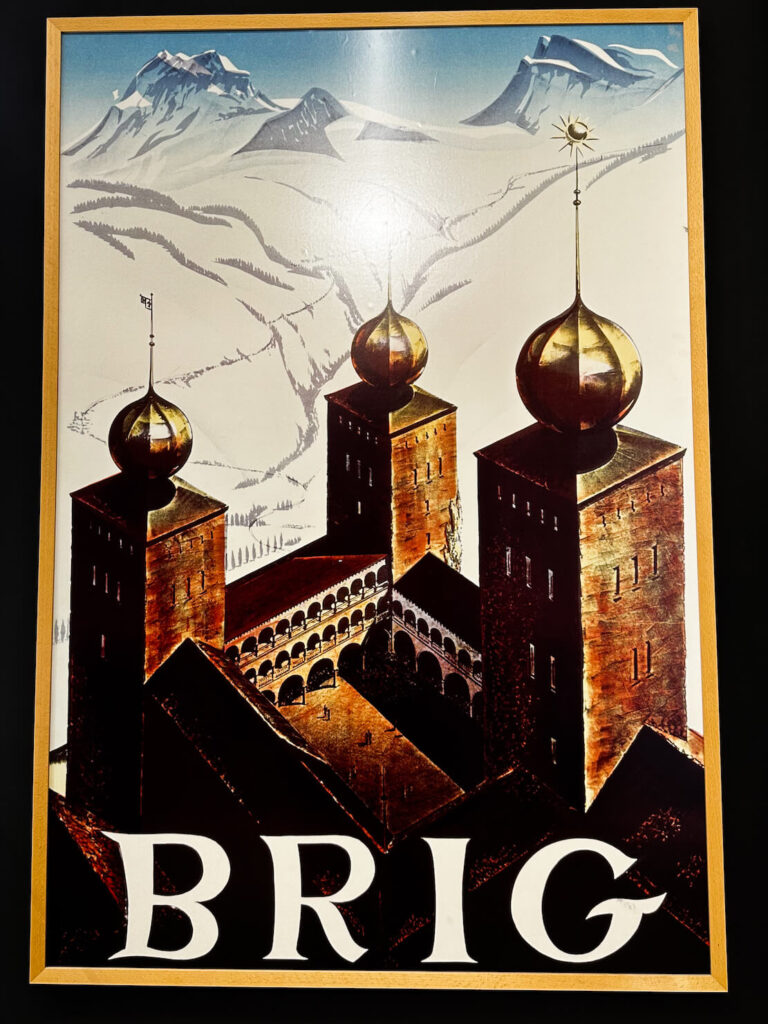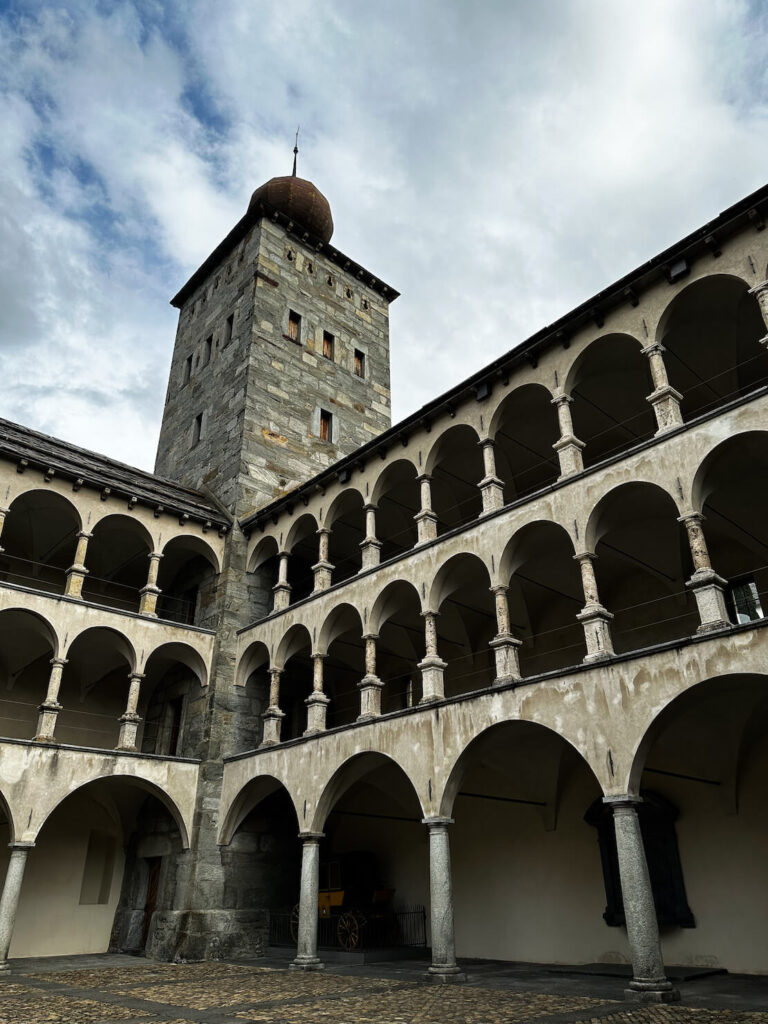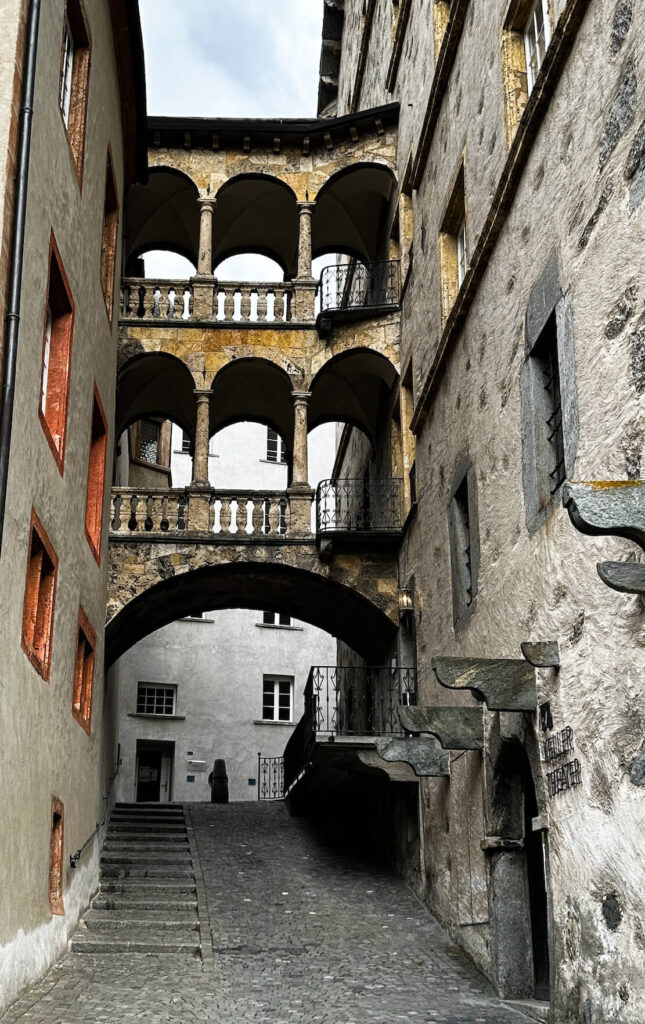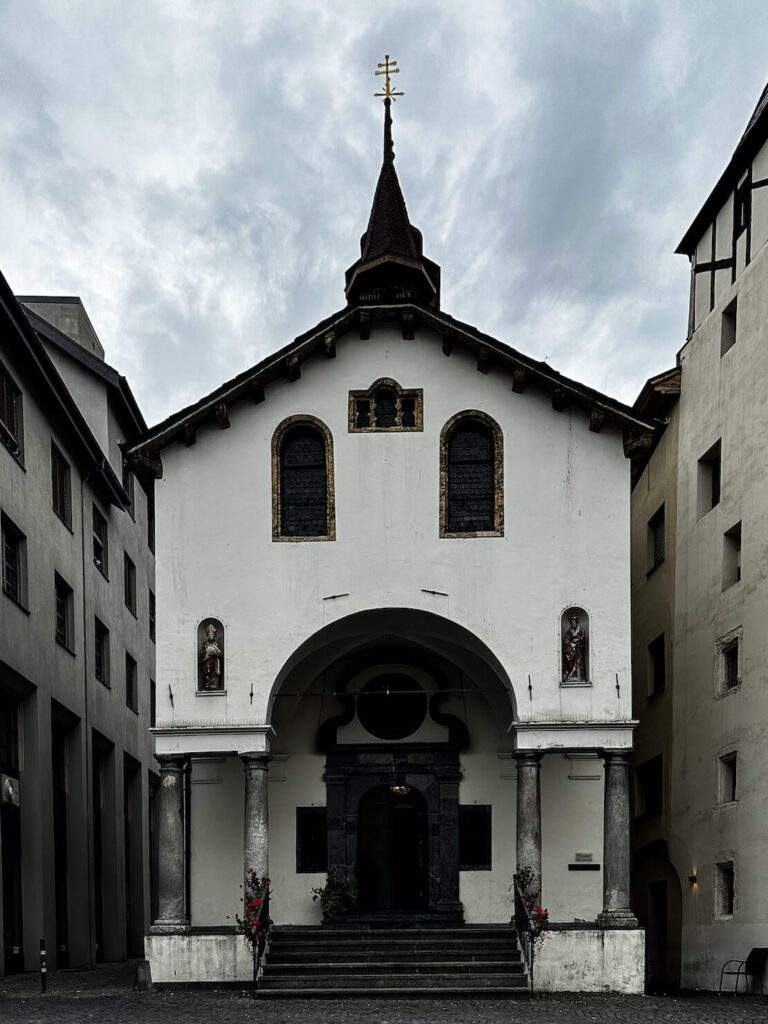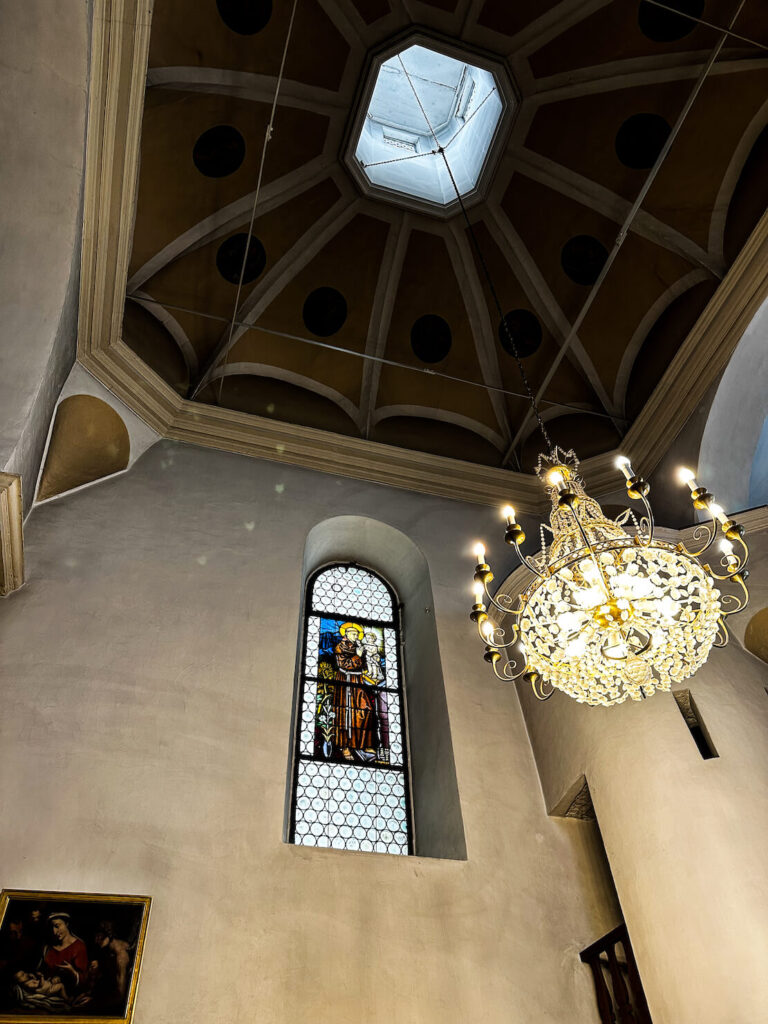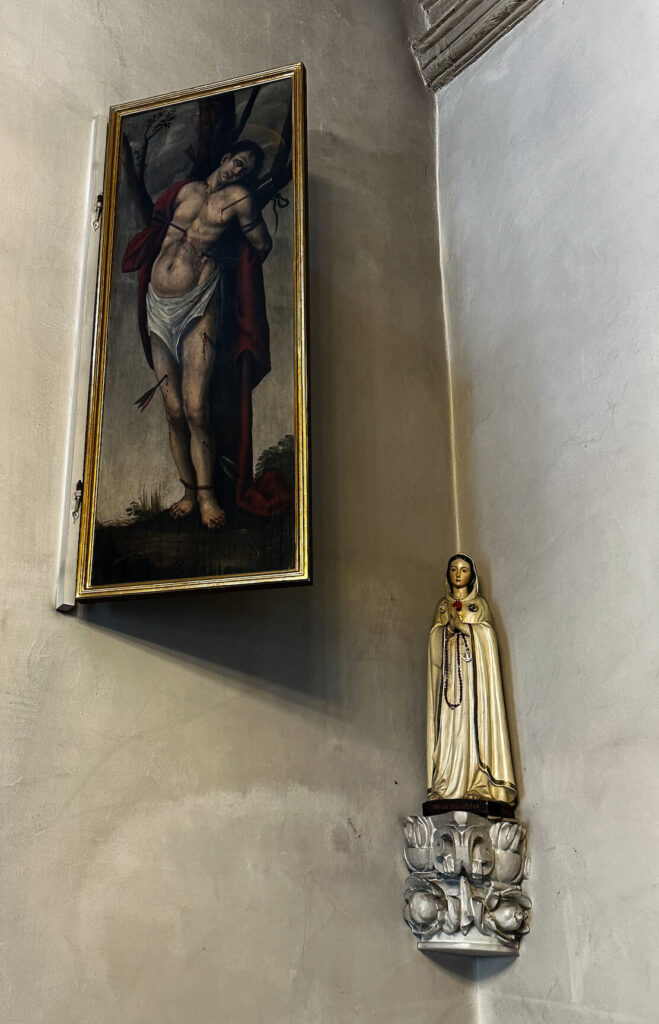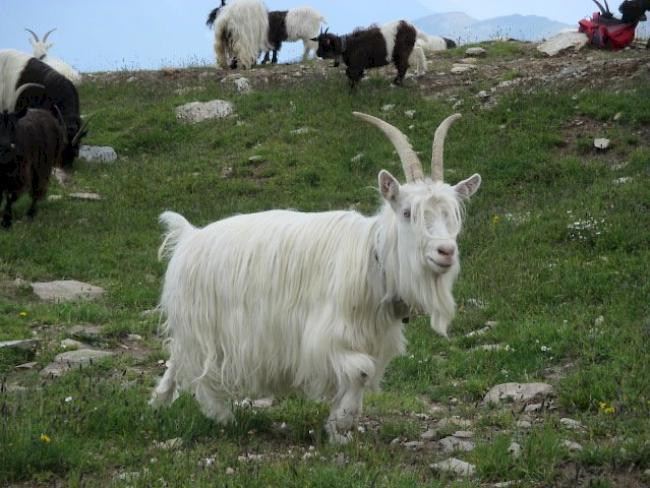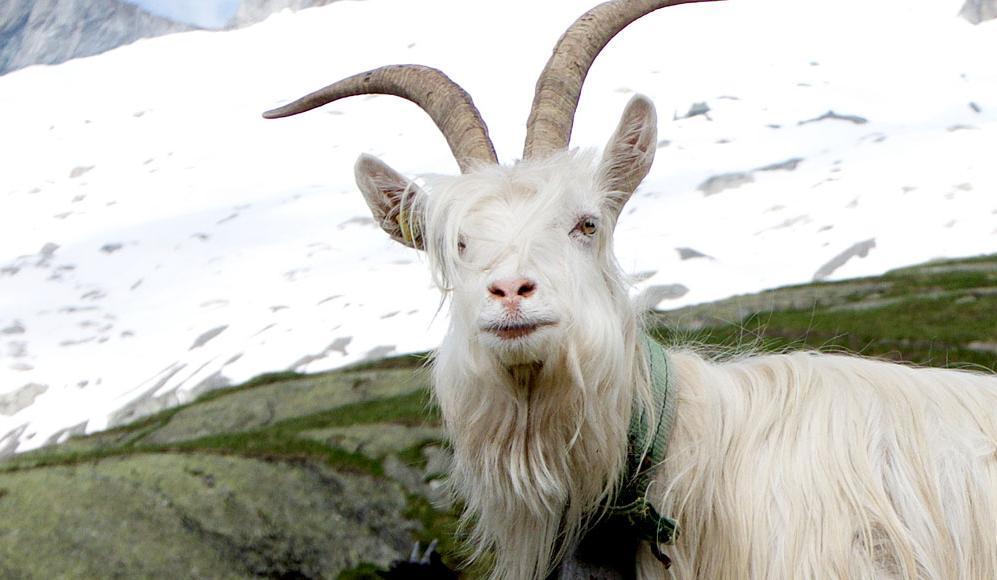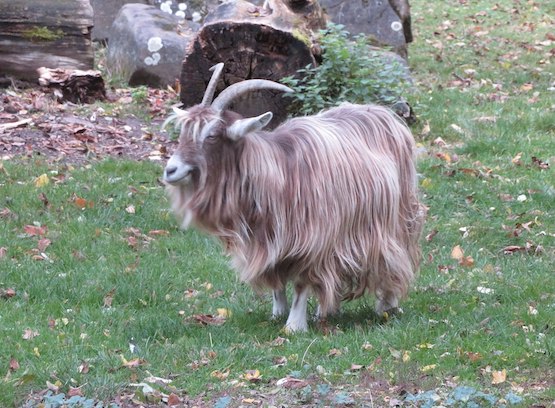In this blog post – unlike in the previous posts – I will cover not one city, but a whole region, the region of Brig Simplon in Wallis canton. As it is a huge area, I made a sort of bucket list. I have tried to select all sorts of activities regardless of the weather. But you can always reach out to my list of things to do in Switzerland in autumn. I hope that I have managed to give you a great overview of this wonderful region. If so, please, drop me a line or two via [email protected] or through my Instagram page. (But write even if you didn’t really like what you read.)
Most of the information comes from the Glacier Express. Yes, from a train 🙂 But think of it much like a hop-on hop-off bus: you get a headset and you listen to interesting facts about the area at each station. I did a bit of research on these snippets and came up with the following bucket list of 10 +1 things to do in the region of Brig Simplon:
- The city of Brig
- Kaspar Stockalper, a wealthy entrepreneur and politician
- Simplon Pass
- César Ritz, from goatherd to hotelier
- The goats of Simplon
- The Aletsch Glacier aka the glacier ruled by prayer
- The goldmine of Gondo
- The legend of Cordon Bleu
- The history of raclette
- The largest Alpine thermal bath, Brigerbad
+1 Glacier Express
The rergion of Brig Simplon in a nutshell
The region of Brig Simplon is located in the south of Switzerland, in the canton of Wallis. The area is between the two small Alpine towns of Brig and Simplon. It includes the Simplon Pass and stretches all the way to the Italian border. The region is a popular tourist destination all year round, rich in ski slopes and hiking trails. The famous Glacier Express crosses the region.
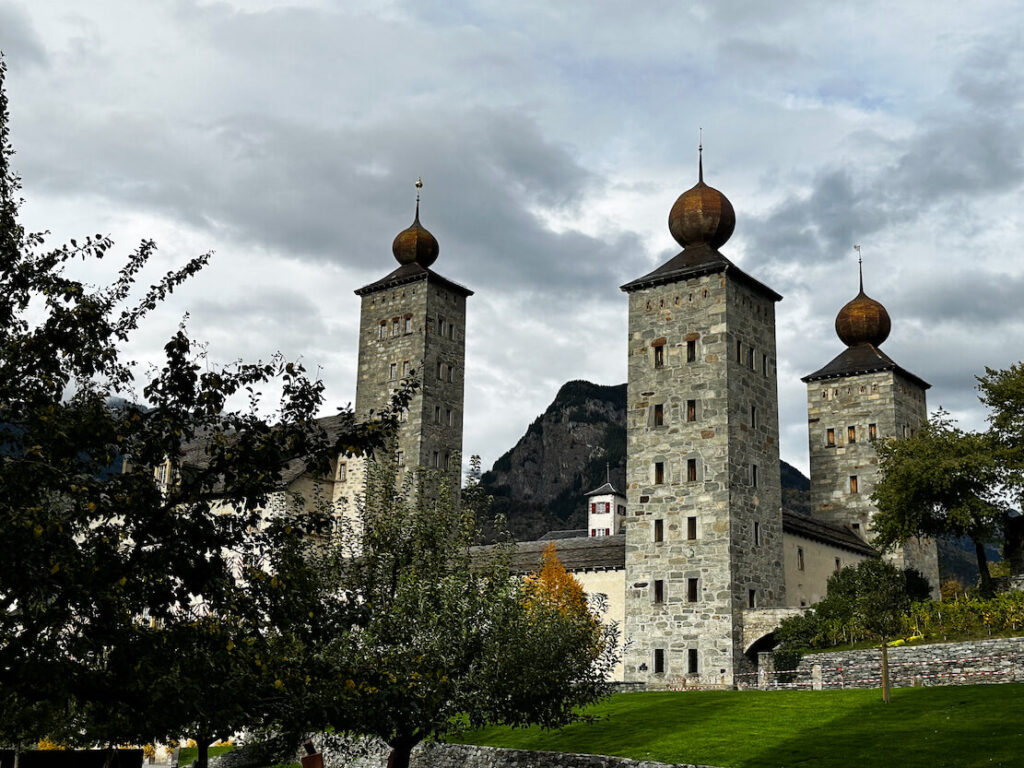
1. The city of Brig
Let’s begin with Brig, one of the eponymous towns of the region. The picturesque Alpine town lies along the Rhone River at the foot of the Simplon Pass, hence the region’s name ‘Brig Simplon’. The area has been inhabited since the Bronze Age, but later the Romans built a road through the valley. The present townscape is dominated by buildings erected in the 17th century. These include the Stockalper Palace, the Sebastian Chapel, and the Jesuit Church (I recommend visiting the sights in this order 🙂 ). As Brig is not a big city, you can easily discover it in a couple of hours. To finish off the day, you should enjoy a glass of local wine on a terrace and try some local dishes (more on local dishes below).
2. Kaspar Stockalper, a wealthy entrepreneur and politician
Kaspar Stockalper, entrepreneur and politician, lived in Brig in the 17th century. He is widely known for his baroque buildings and the Stockalperweg, a trade route through the Simplon between Switzerland and Italy. As governor, he had unlimited power in the region: he was the supreme head of the legislature, the executive, and the judiciary.
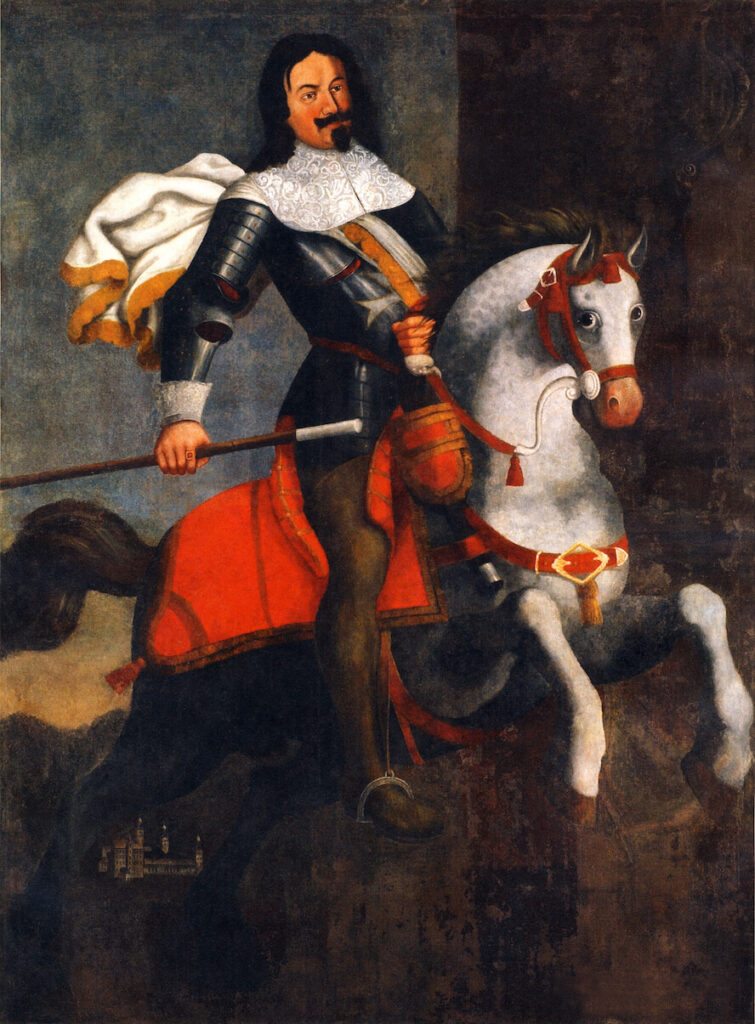
He monopolized all trading business in Simplon, including the highly lucrative salt trade and transportation. However, to maintain this system he needed a lot of manpower. As a matter of fact, at the peak of his power, Kaspar employed around 5,000 people, while at that time Brig only had about 900 residents. During his reign, he made a fortune of 2 million Valais pounds. To put it in perspective, it was so much money that you could buy so many cows with it that if you lined them up, you’d have a 270-kilometer-long ‘chain of cows’. So, it was no wonder that the wealthy families of the region were a bit fed up after a while. They formed an alliance and exiled Stockalper to Domodossola. There’s much more information on Stockalper’s story in a pretty cool video on the Stockalperweg website (in German though), and in the Stockalper Castle Museum in Brig.
3. Simplon Pass
The Simplon Pass is one of the most beautiful alpine routes to Italy. Briefly about its history: the pass was known as far back as the Stone Age, but until the 17th century it was mainly used by smugglers and mercenaries. Then, in the 18th century, the above-mentioned Kaspar Stockalper showed up and started to build the route we know today.
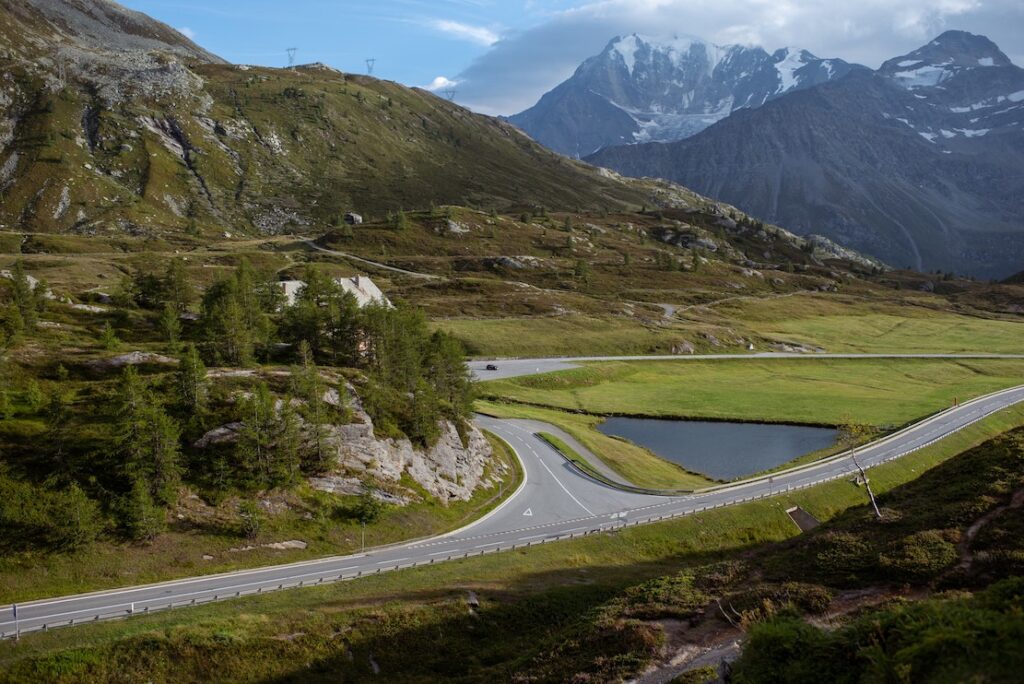
In Brig, there’s a free exhibition about the most important stages of the history of the mountain pass. And for those who prefer to visit it in real life, there are a number of hiking trails and you can also cross the Simplon pass by train. In summer, you should definitely visit the area around Lakes Rotel and Hopschusee, and in winter, it’s a cool place for skiing. Finally, I highly recommend the Stockalper hiking trail for real hardcore hikers. It’s a 35 km long trail from Brig to Gondo (where the gold mines are located) via the Simplon Pass. And the trail is completely preserved in its 17th-century form. You can cover it in three days, with overnight stops at the Simplon Pass and Simplon village. And if you’re really adventurous, you can continue all the way to Domodossola.
4. César Ritz, from goatherd to hotelier

The founder of the world-famous hotel chain, César Ritz comes from the region of Brig Simplon too. He was born in 1850 in Niederwald into a poor peasant family. As the youngest of thirteen children, he was forced to learn the meaning of hard work at a young age. He worked among others as a goat herder and waiter. On the other hand, studying apparently wasn’t his thing. His father took him out of school because of his ‘laziness’.
At the age of 17, he got fed up with his father’s strictness and moved to Paris, where he worked as a shoeshine boy, a doorman, and later as a room-service waiter. By the late 1890s, he had hotels in Rome, Biarritz, Monte Carlo, Lucerne, and even Cairo. At that time, he was not even 50 years old. You can learn more about his life and work through a 5 km hiking trail from Niederwald to Blitzingen and an exhibition at the Stazion Ritz museum. Information about the tour here and about the museum here.
5. The goats of Simplon
Well, it’s not just famous people that the Brick Simplon region is home to, but also to the so-called Sempione goats. And if you’re wondering why I’m featuring a goat breed on the Brig Simplon bucket list, you should check out the album below. Aren’t they cute?
They’re pretty unmistakable, so you’ll know for sure if you’re looking at the ‘right’ goat. Sadly, it is now a critically endangered species, to the extent that it has been listed as extinct on several occasions. So if you meet one or two, be careful! All for the eyes, none for the hands, if possible don’t bother them.
6. The Aletsch Glacier aka the glacier ruled by prayer
The Aletsch is the largest glacier in the Alps, it’s 23 km long and it’s located in the eastern Bernese Alps. So much for the dimensions of the glacier, let’s talk about its history now. Not so much the glaciers but its dimensions’ history.
The Aletsch Glacier has grown and grown over the centuries (as all glaciers do), threatening the survival of the surrounding villages. By the 17th century, the situation had reached the point where the inhabitants of the area finally decided to do something about the threat of the glacier. Their solution was very simple, they decided to make a vow to God to lead virtuous lives. The vow was even blessed by the Pope, and once a year the people of the area would hold a procession and pray together against the growth of the glacier.
Apparently, it all has worked so well that the glacier is not only not growing, but has started to shrink to a critical extent. The villagers felt they had to do something again. The parish priest of Fiesch asked for the Pope’s blessing (which he received in 2010) so that they can pray for the glacier to grow. We’ll see if it’s gonna work…

The Aletsch Glacier area offers a wide range of outdoor activities. And while I am not against prayer, even church leaders acknowledge that global warming has contributed greatly to the melting of the glacier. With this in mind, I am not sure that thousands of tourists should be visiting the immediate area of the glacier. In any case, if you want to see the glacier up close, this website has a lot of useful information (and surprise, surprise it’s in English).
7. The gold mine of Gondo
Gondo is a small mountain village, home to the oldest gold mine in the canton of Wallis. And therefore a mandatory item on our top ten bucket list for Brig Simplon.
It is believed that gold ore was mined in the area as early as Roman times. But also later, around 1550, there were gold mines mentioned in the valley. However, the first time gold deposits were officially known was only in 1660, which is when (ofc) Kaspar Stockalper appeared on the scene. As soon as he heard of the large gold reserves, he bought the land on which the former Gondo gold mines nowadays stand. Then he built facilities for gold mining and had miners transport the extracted ore.
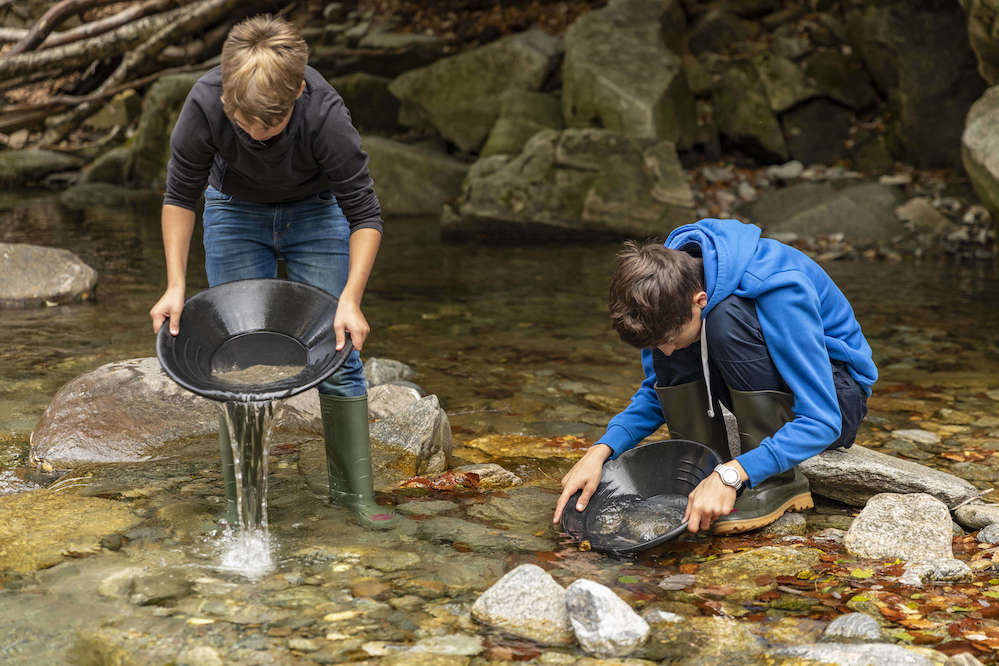
In the late 1800s, the technological innovations of the time – new cableways, electric power stations, hydroelectric power – made larger-scale works possible. As a result, at the peak of the Gondo gold rush, 5191 tonnes of gold ore were mined in just a year and a half. And what about today? In 1993, according to the Swiss Geotechnical Commission’s inventory of raw materials, there were some 250 000 tonnes of workable ore still containing 50% gold, and an estimated 250 000 tonnes of unexplored gold veins. Nowadays, the area is mainly a tourist attraction. Visitors can learn about the history of gold mining in Gondo through a number of activities. There are guided tours in the mines, but you can also try gold panning in the rivers.
8. The legend of Cordon Bleu
Legend has it that two hundred years ago Cordon Bleu was “invented” in the region of Simplon Brig, more precisely in Brig. To illustrate the importance of the subject, I must point out that in French slang, they call the really good cooks ‘cordon bleu’. So, if you would like to recognize a proper chef in the future, you must try the local Cordon bleu. You know, just for the sake of it (And also because it’s super delicious. Otherwise I would not have added it to the ultimate Brig Simplon bucket list.)
But let’s go back a bit to the history of cordon bleu. According to legend, two hundred years ago, a group of people made a dinner reservation at a restaurant in Brig, and the cook arranged the meat accordingly. Suddenly that evening, a second group showed up unannounced for dinner too, but there was only enough pork for one group. For this reason, the chef had to be very creative: she cut the pork loin in half without the knife going all the way through the meat and stuffed it with slices of ham and cheese. And now, thankfully, there was enough food for both groups. Impressive ingenuity. 🙂 The original recipe is available on this website, but if you’re in the area, you should definitely visit a local restaurant.
9. The history of raclette

Indeed, it is believed that another world-famous dish, the raclette, also comes from the region of Brig Simplon. Its story of origin is not as exciting as that of the Cordon Bleu, still, the Valais specialty is now known all over the world. Legend has it that one cold day, Léon, a Wallis winemaker, heated a piece of cheese over an open wood fire, the cheese melted and voilá, raclette was born.
But then again, cheese melting was already known in Valais in the 1500s. The word raclette itself comes from the word “racler”, which means “to scrape” in the local French dialect. After melting over the fire, they carefully scrape the cheese off the cheese wheel. You can eat raclette practically anywhere in the Brig Simplon region. I honestly can’t imagine any restaurant would prepare it badly. We tried it in this restaurant in Brig.
10. The largest Alpine thermal bath, Brigerbad
On hot summer days, visit Brigerbad, the largest outdoor thermal bath in the Alps. It’s also home to the longest Alpine waterslide, 182 metres long and 23 metres high. Of course, I didn’t dare try it.
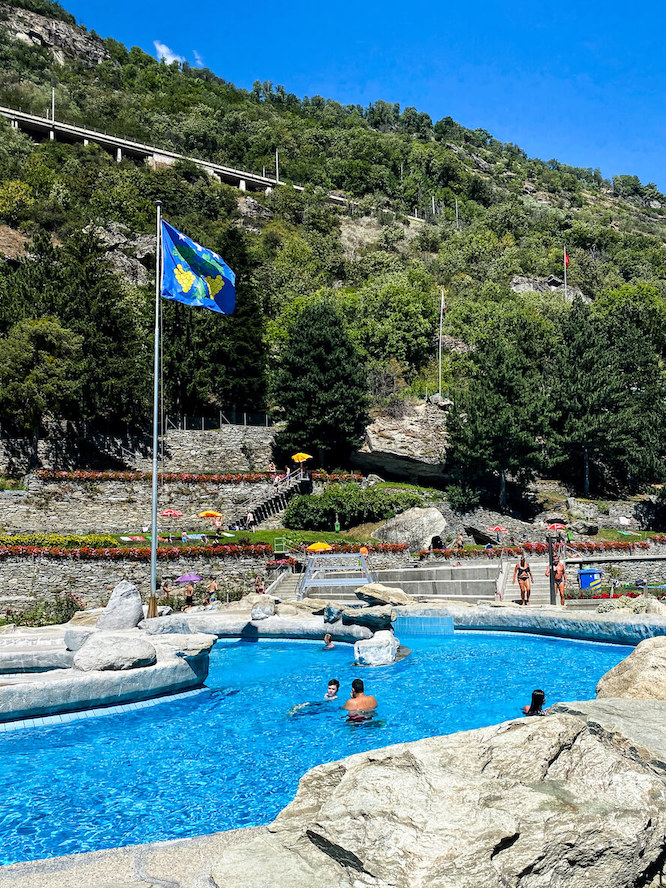
A little bit of history…
The hot springs near Brigerbad were supposedly already used by the Romans. The baths flourished in the 16th century when major extensions were made. New bathing cabins and an inn were built. Also, the gardens were redesigned with walking paths and vineyards. Then, in the 17th century, our friend, the ambitious Kaspar Stockalper, discovered the place too. At this time, some tunnels collapsed and the flooding of the Rhone filled the bathing huts with mud. This did not discourage Stockalper from his goal. He commissioned his men to dig new springs and install new bathing sites.
It took its current form during a renovation and refurbishment in 1996 and in 2014. We visited Brigerrbad in the summer, but I also recommend it in the colder months, as it has a very nice Spa and Wellness area. Indoor pool, cave bath, numerous steam rooms, and saunas. So basically everything you could possibly need for a relaxing wellness weekend.
+1 Glacier Express to the Brig Simplon region
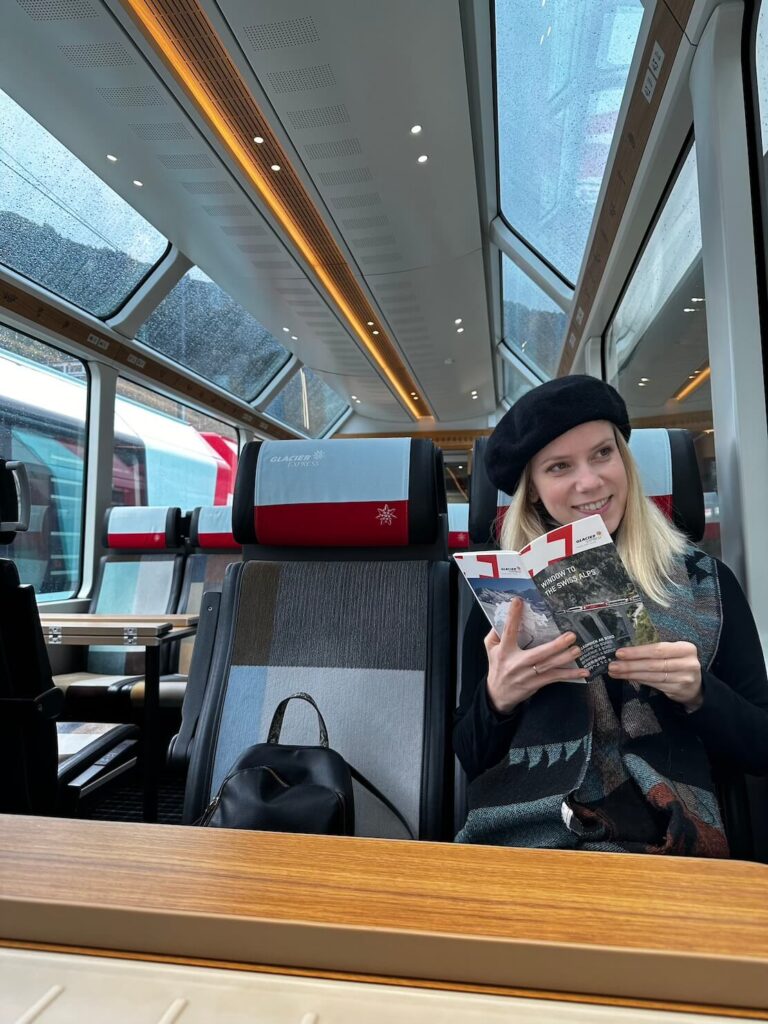
The Glacier Express is arguably one of the most beautiful railway lines in the world. It’s running through the Swiss Alps, linking the famous resorts of St Moritz/Davos and Zermatt. I’ve added it to the bucket list because it also passes through Brig Simplon. So if you’re in the area, it’s worth a ride. A journey like this can be super charming. Just imagine! The train has just passed over a viaduct, and we’re admiring the picturesque scenery with a glass of wine in our hands. To the left, mountains and waterfalls, to the right, gentle green countryside with grazing cows. The Glacier Express runs first and second-class coaches. It has its own kitchen, and serves everyone in their seats, regardless of coach class.
I also really liked that we were given a welcome pack with maps, brochures, hand sanitiser, honey biscuits, and headphones. Yes, we also got headphones. Because, like on a hop-on hop-off bus, they share interesting facts about the history of the sights. Finally, let’s not forget that there are also regular trains in the region. And those, unlike the Glacier Express, do not require a seat reservation. The GA is valid for both. But if you don’t want to pay an extra 39 francs for seat reservations, you can use the regular trains. More information about tickets and the train itself is here.
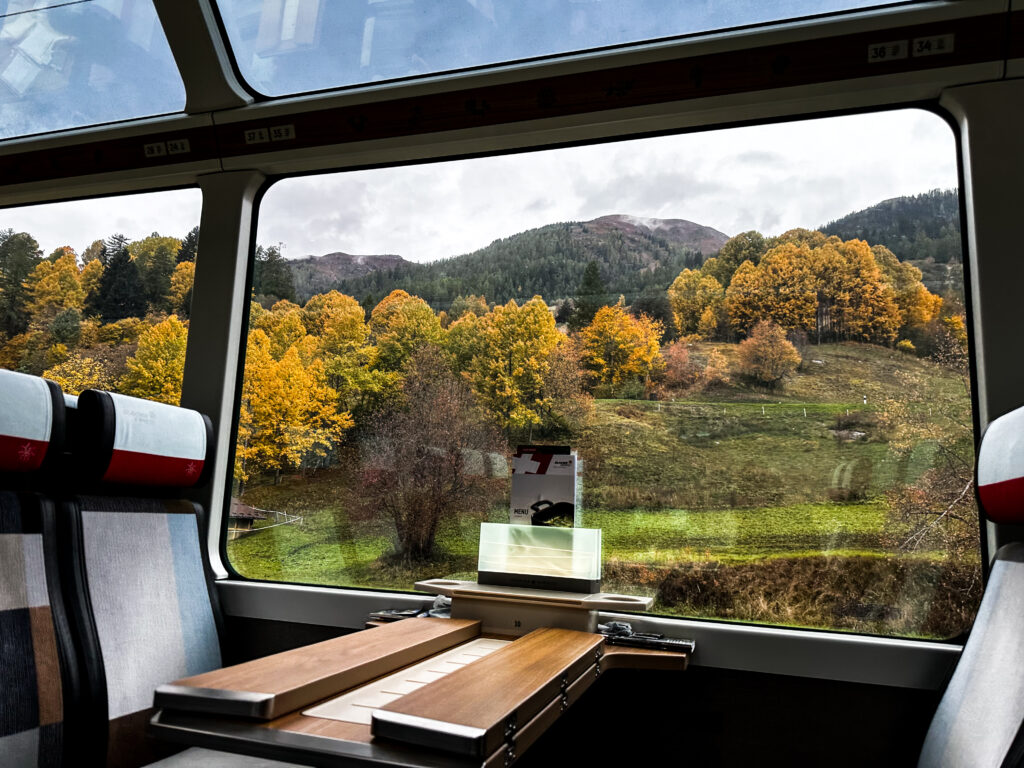
Sources, references:


